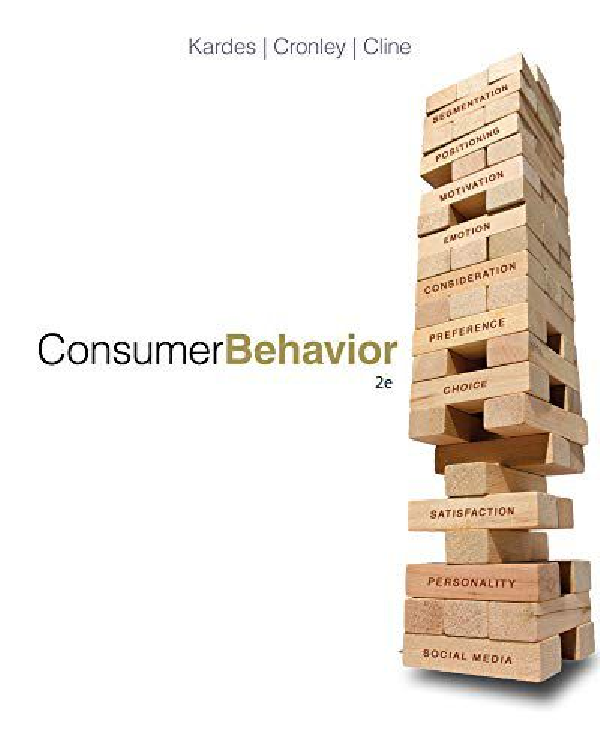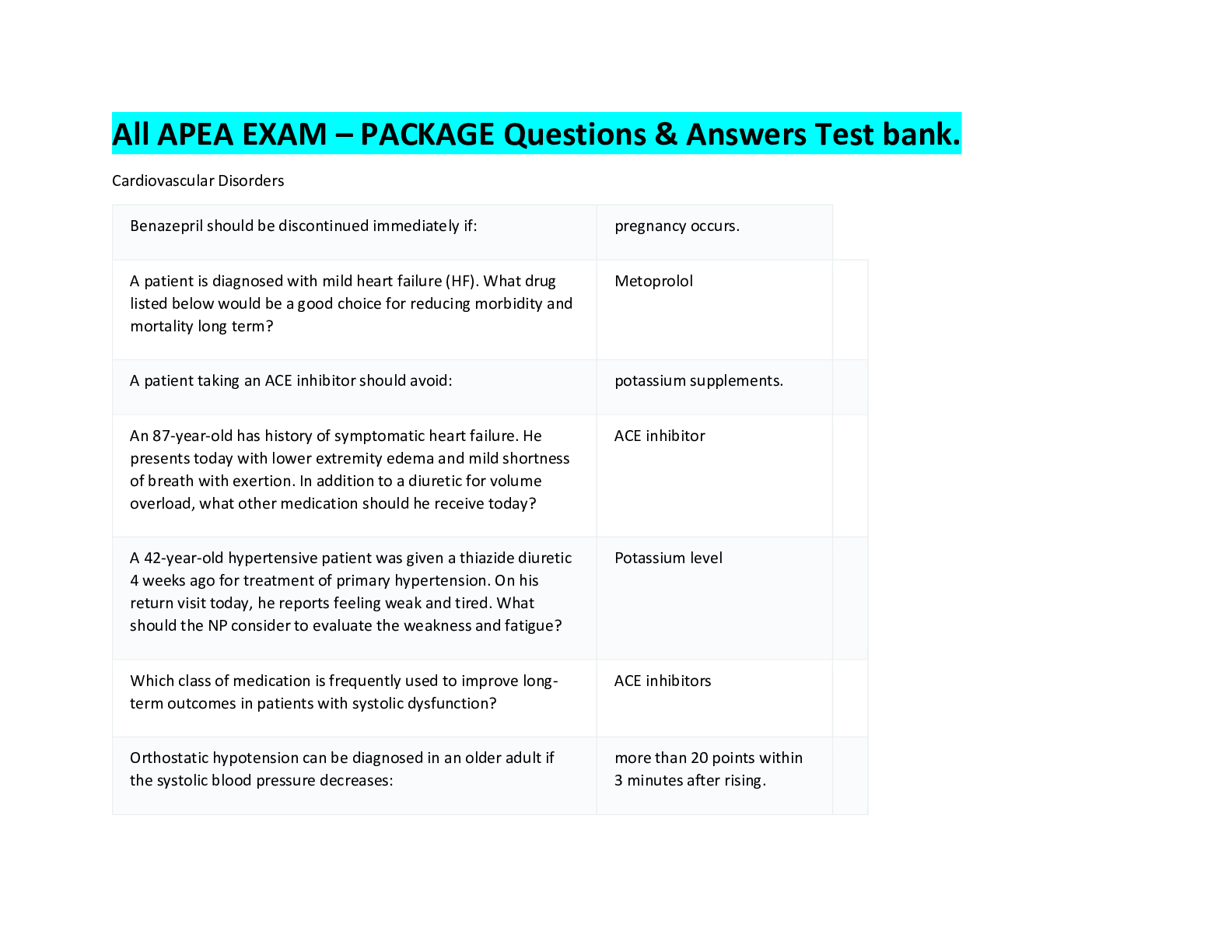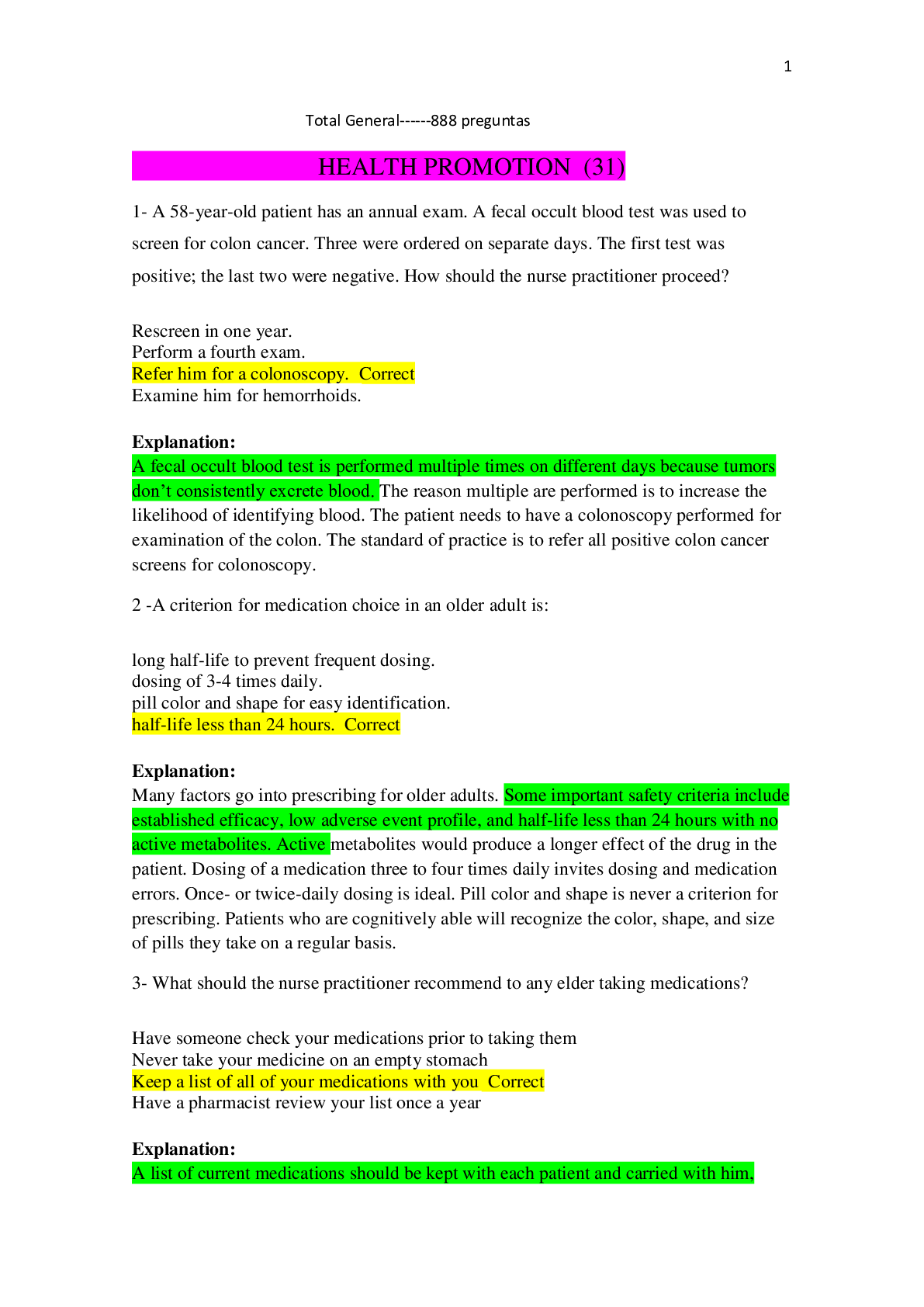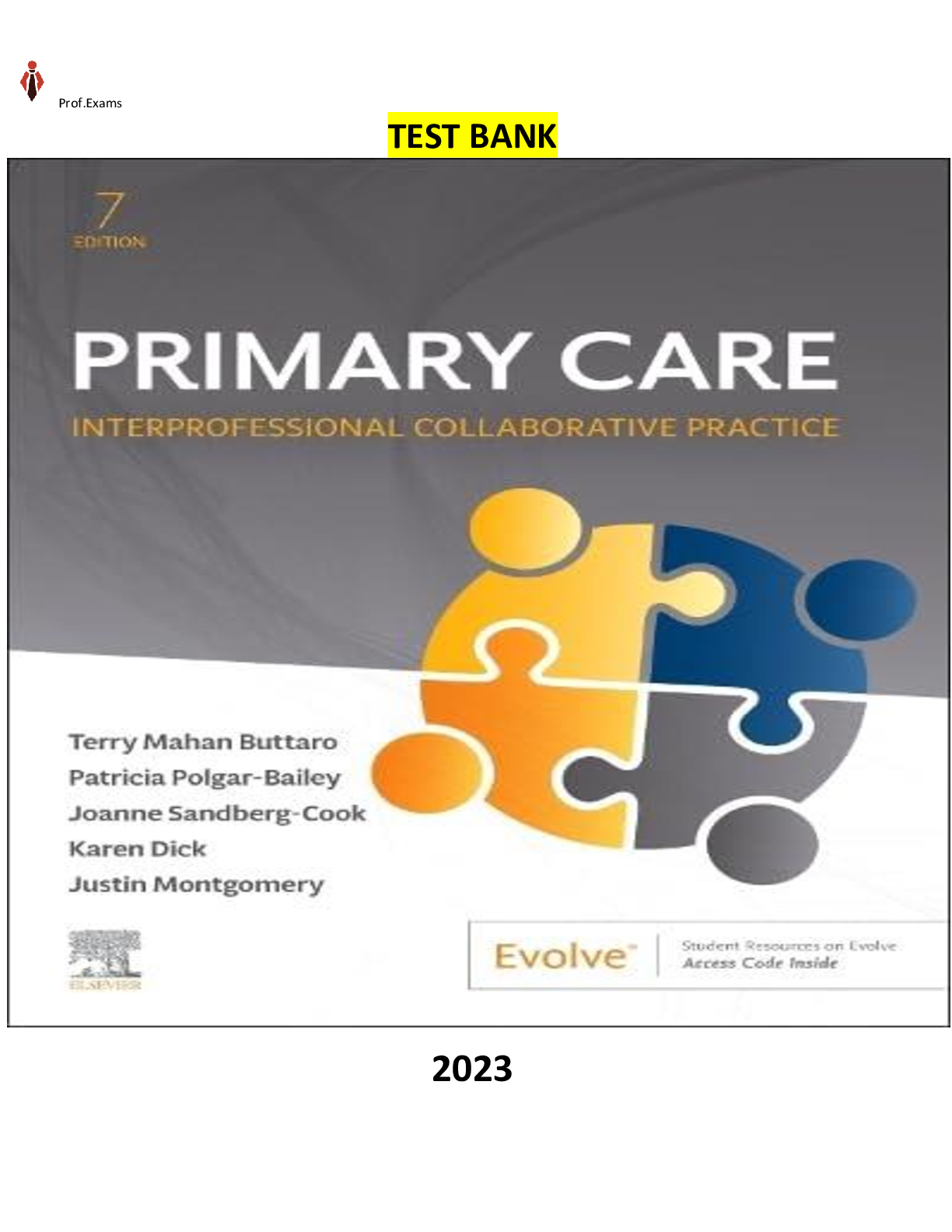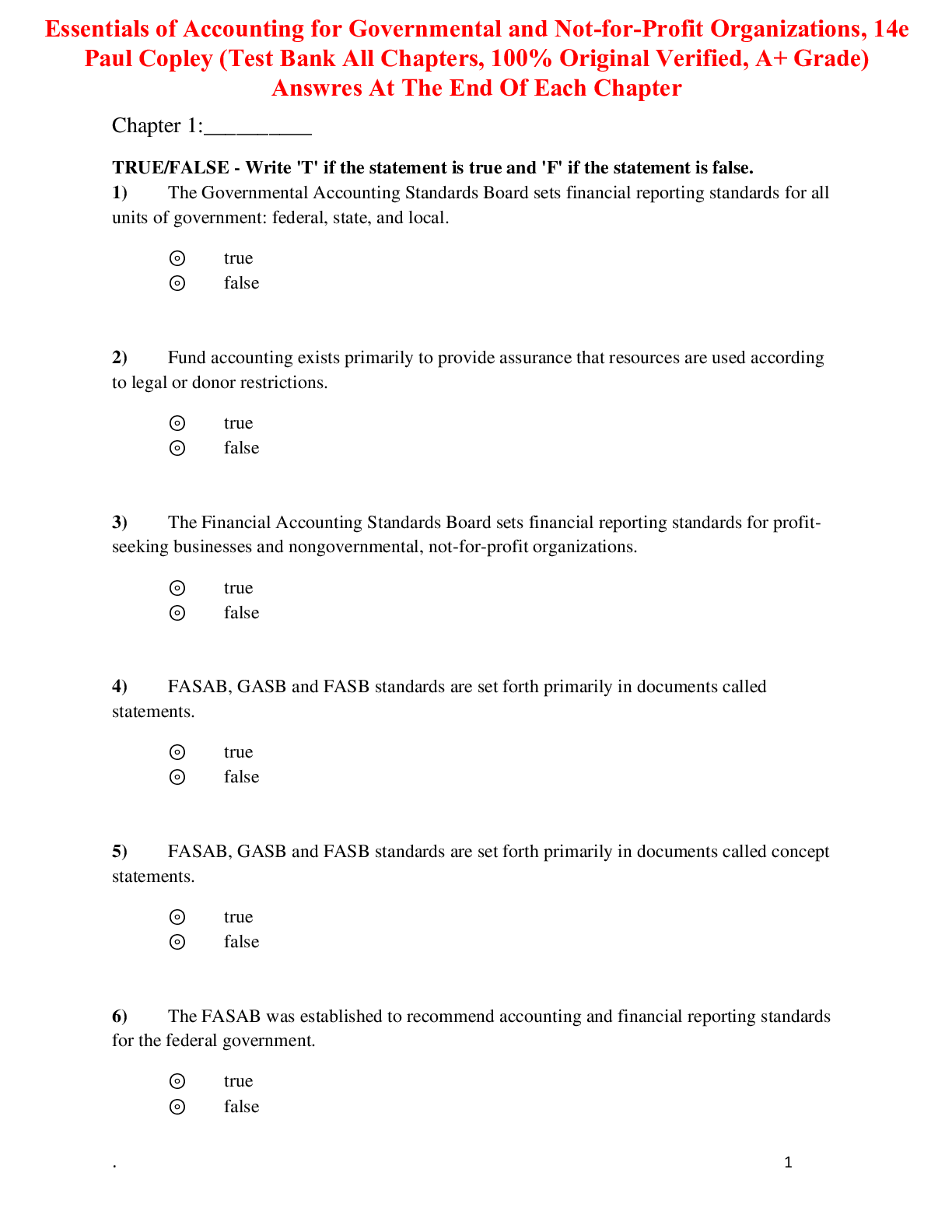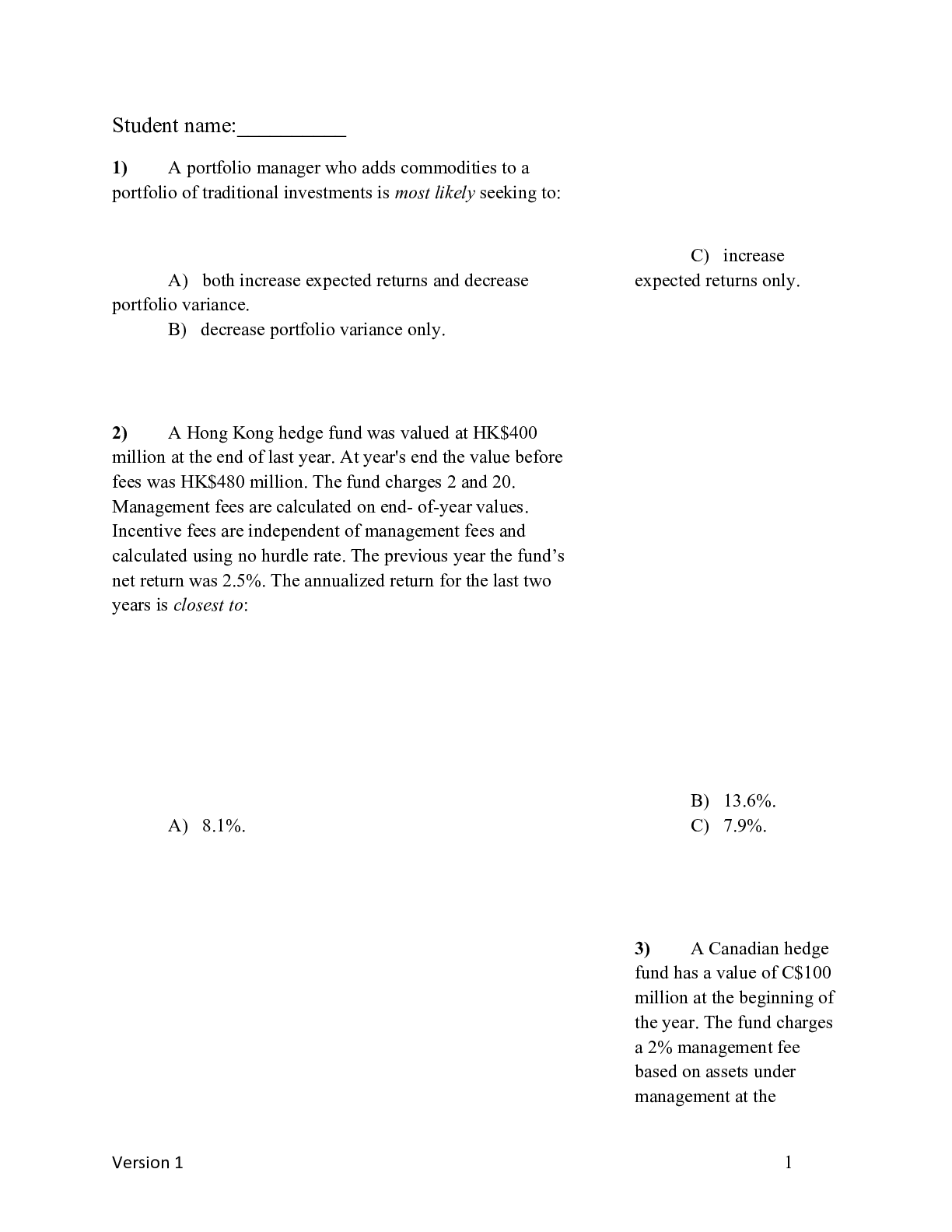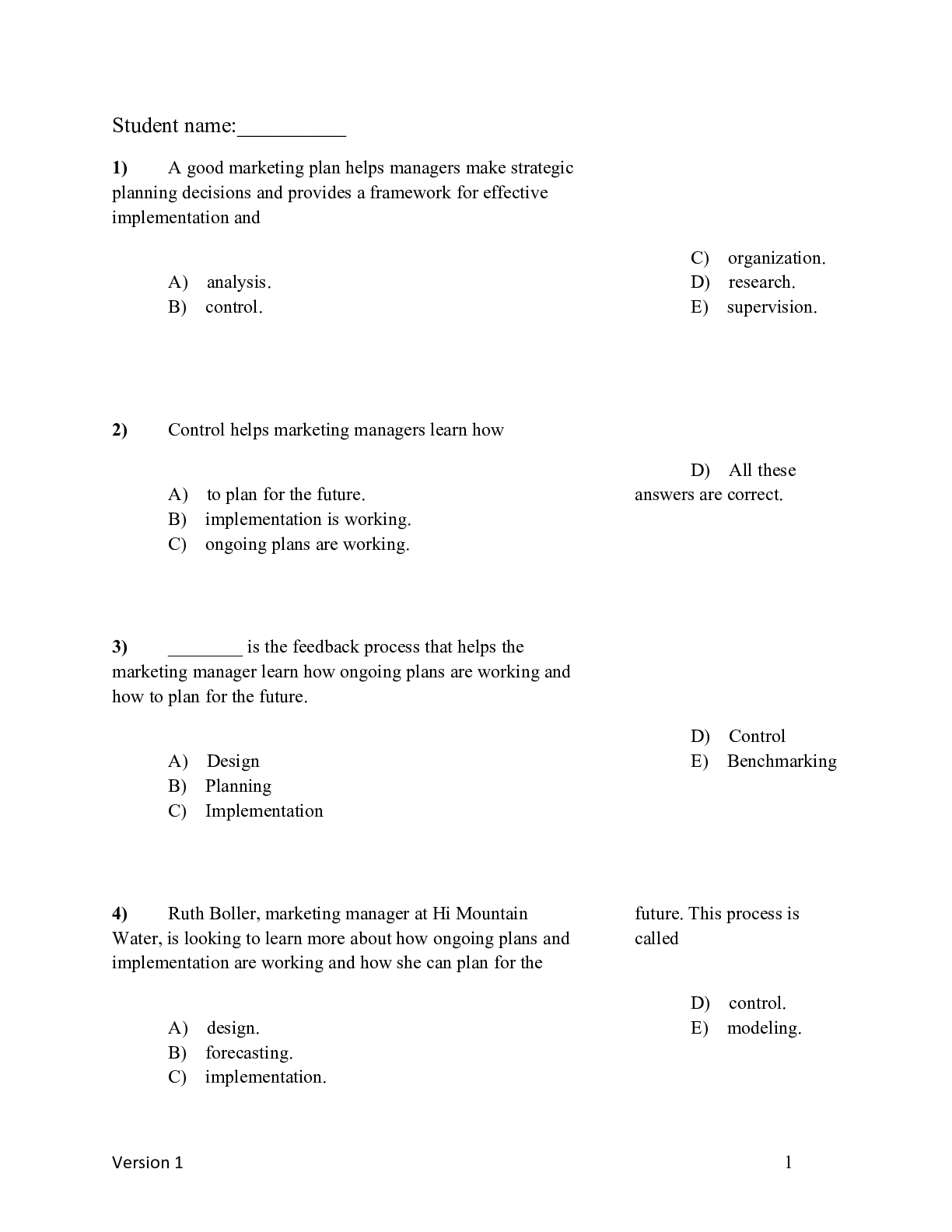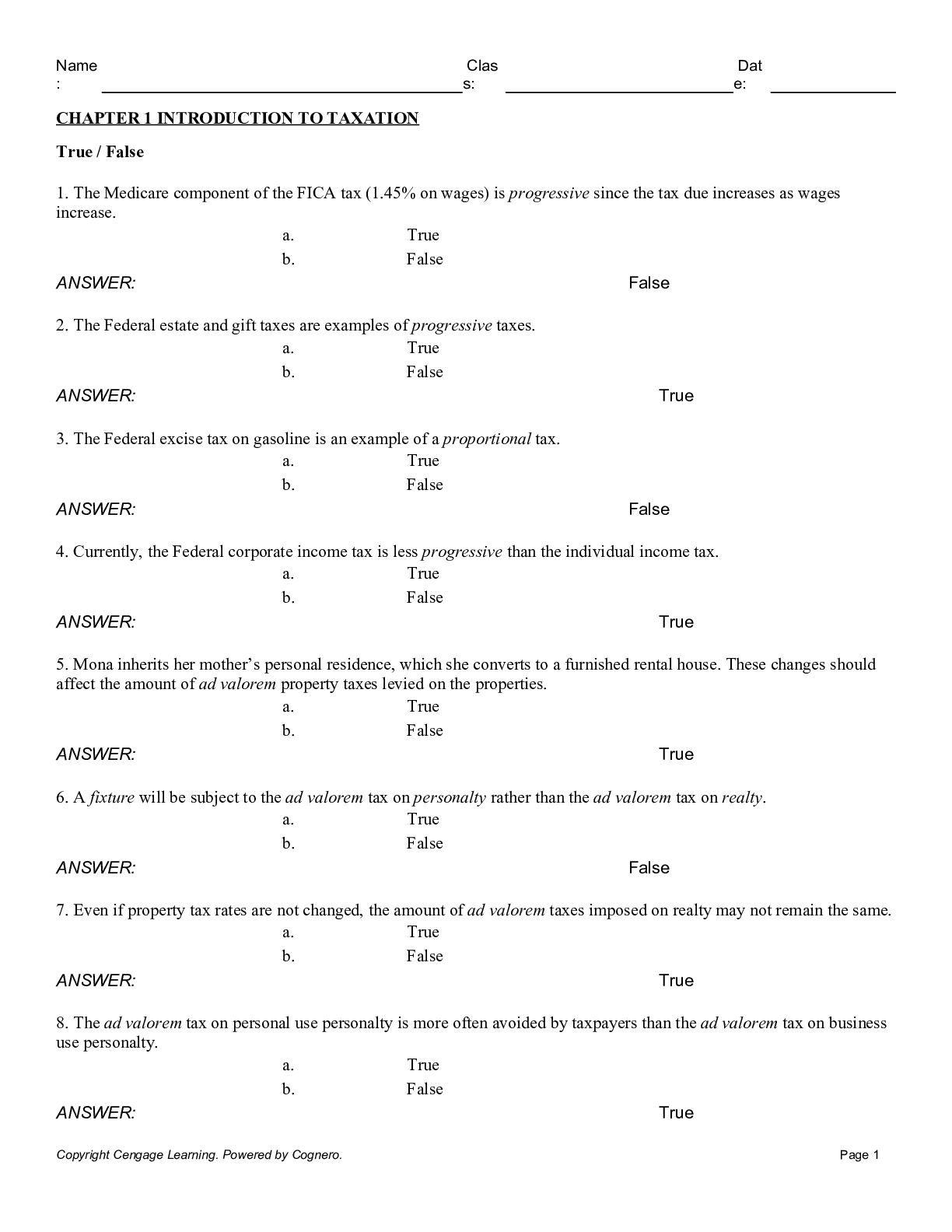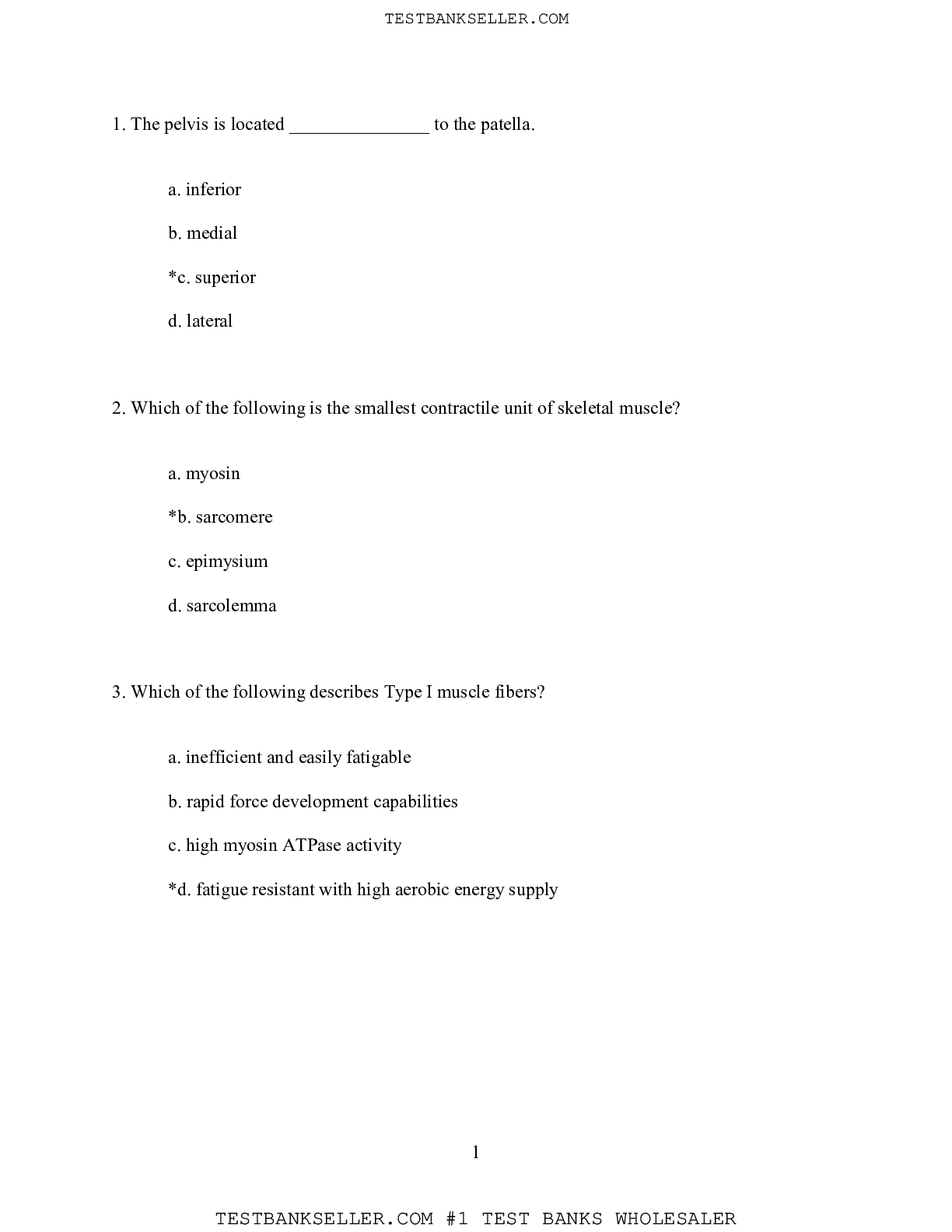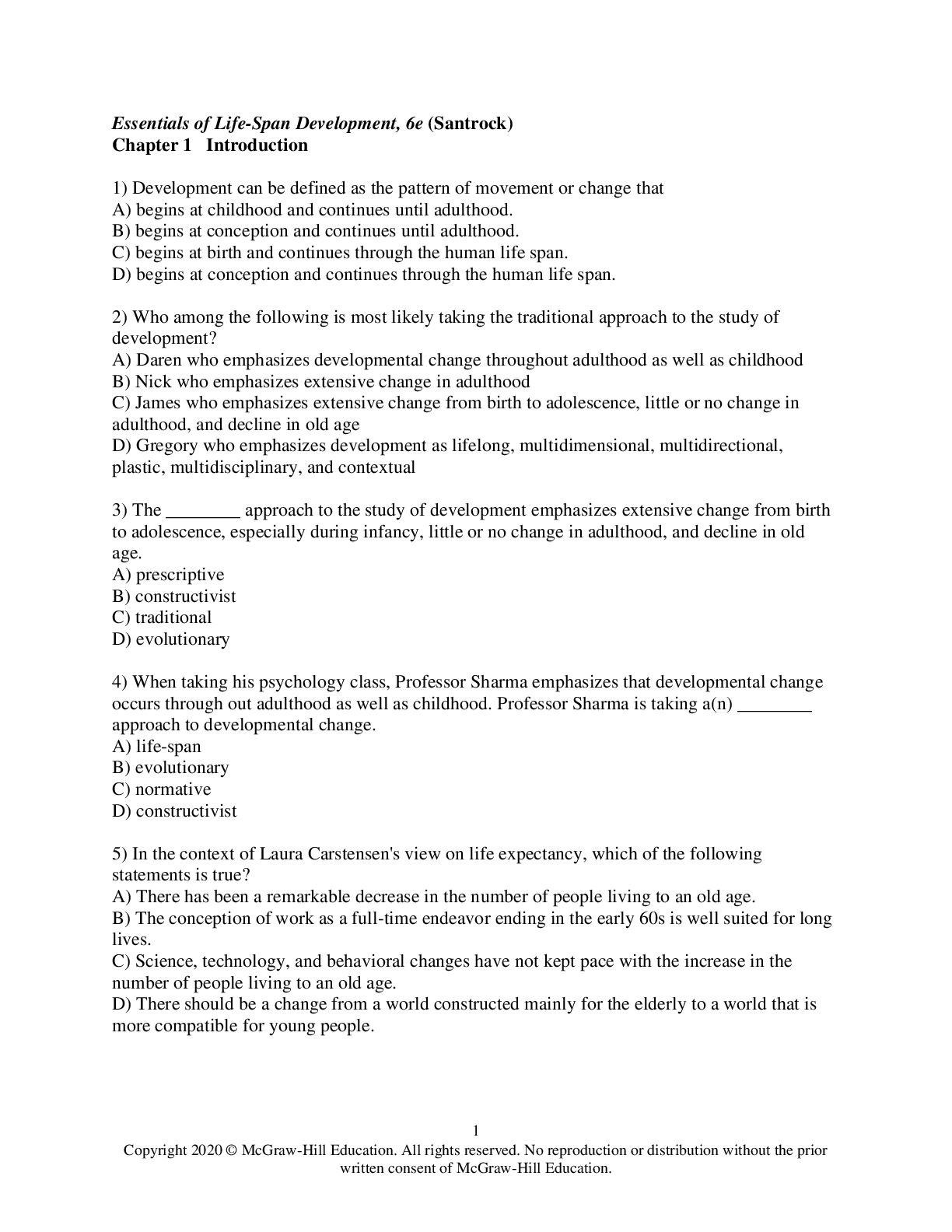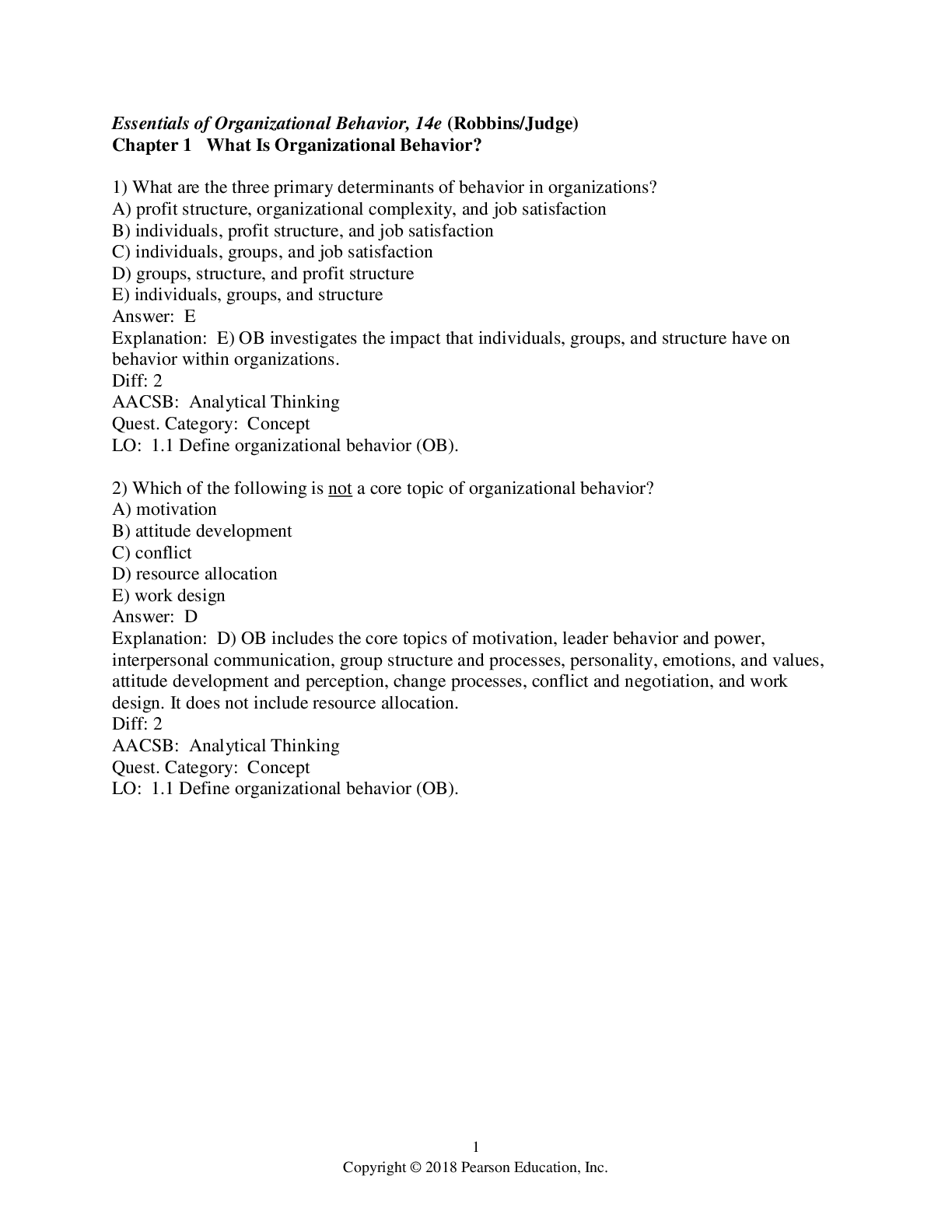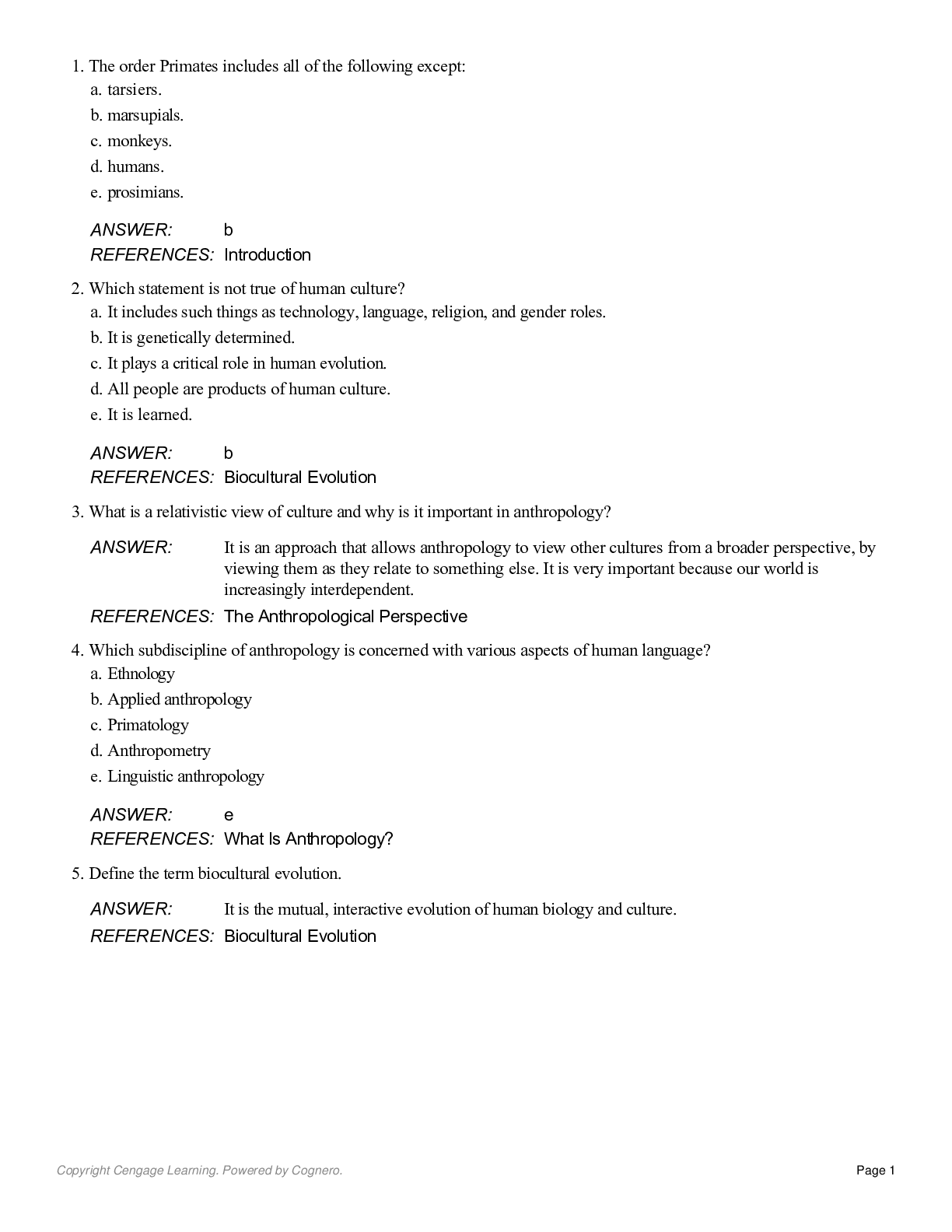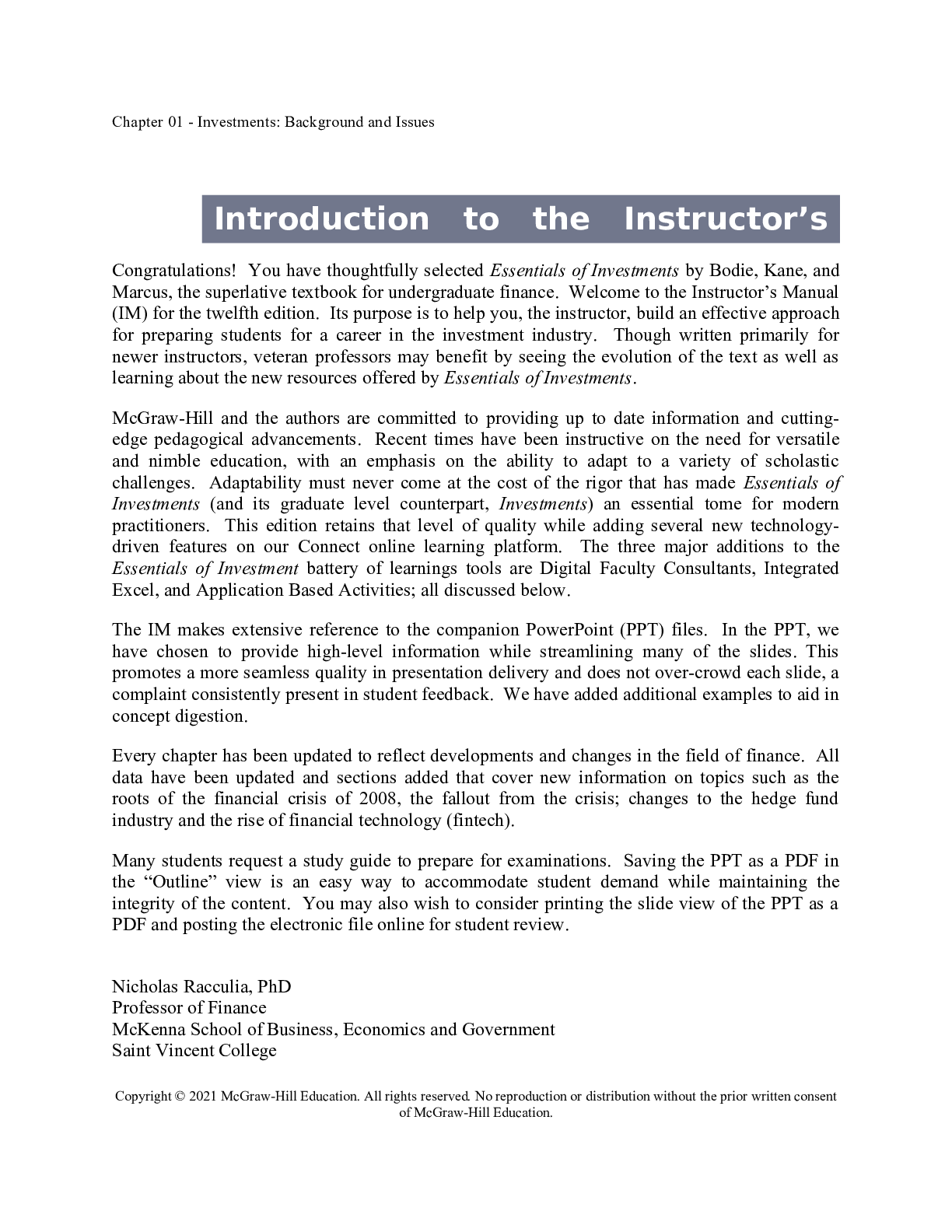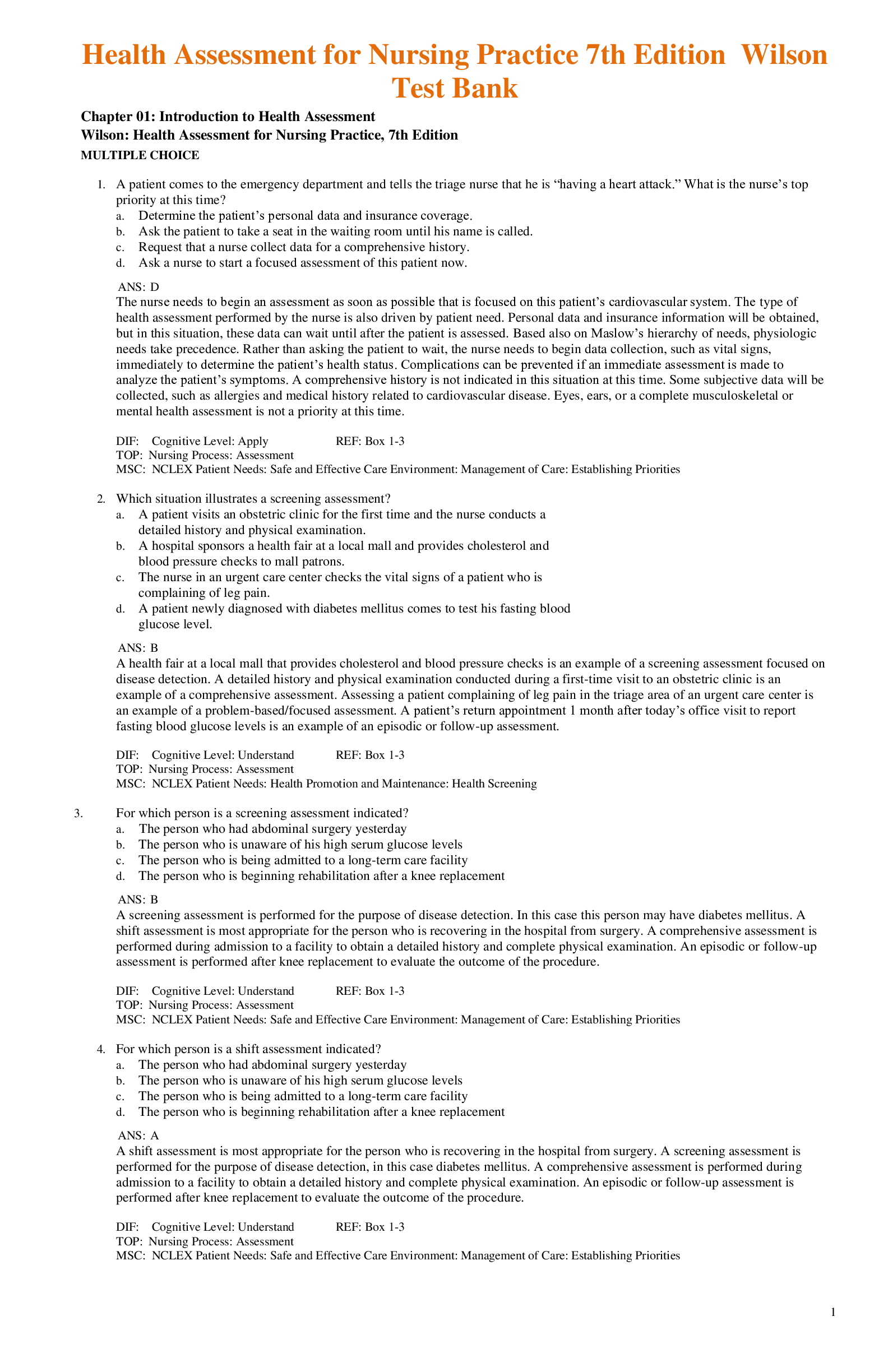Psychology > TEST BANK > TEST BANK for Essentials of Psychiatric Mental Health Nursing: Concepts of Care in Evidence-Based Pr (All)
TEST BANK for Essentials of Psychiatric Mental Health Nursing: Concepts of Care in Evidence-Based Practice 7th edition by Townsend & Morgan.
Document Content and Description Below
TEST BANK for Essentials of Psychiatric Mental Health Nursing: Concepts of Care in Evidence-Based Practice 7th edition by Townsend & Morgan. Contents Unit 1 Introduction toPsychiatric MentalHealth C... oncepts Chapter 1 Mental Health and Mental Illness Introduction Mental Illness Mental Health Physical and Psychological Responses to Stress Physical Responses Psychological Responses Summary and Key Points Chapter 2 Biological Implications Introduction The Nervous System: An Anatomical Review The Brain Nerve Tissue Autonomic Nervous System Neurotransmitters Neuroendocrinology Pituitary Gland Circadian Rhythms Genetics Psychoneuroimmunology (PNI) Normal Immune Response Psychopharmacology and the Brain Implications for Nursing Summary and Key Points Chapter 3 Ethical and Legal Issues Introduction Ethical Considerations Theoretical Perspectives Ethical Principles Ethical Dilemmas A Model for Making Ethical Decisions Ethical and Legal Issues in Psychiatric Mental Health Nursing Legal Considerations Nurse Practice Acts Legal Issues in Psychiatric Mental Health Nursing Types of Law Classifications Within Statutory and Common Law Hospitalization Nursing Liability Summary and Key Points Chapter 4 Psychopharmacology Introduction Historical Perspectives Role of the Nurse Ethical and Legal Implications Medication Administration and Evaluation Assessment Client Education How do Psychotropics Work? Applying the Nursing Process in Psychopharmacological Therapy Antianxiety Agents Antidepressants Mood-Stabilizing Agents Antipsychotic Agents Sedative-Hypnotics Agents for Attention Deficit/Hyperactivity Disorder (ADHD) Summary and Key Points Chapter 5 Cultural and Spiritual Concepts Relevant to Psychiatric Mental Health Nursing Cultural Concepts How Do Cultures Differ? Communication Space Social Organization Time Environmental Control Biological Variations Application of the Nursing Process Background Assessment Data African Americans American Indian and Alaska Natives Asian/Pacific Islander Americans Latino Americans Arab Americans* Cultural Syndromes Planning and Implementation Evaluation Spiritual Concepts Spiritual Needs Religion Addressing Spiritual and Religious Needs Through the Nursing Process Assessment Diagnoses and Outcome Identification Planning and Implementation Evaluation Summary and Key Points Unit 2 Psychiatric MentalHealth Nursing Interventions Chapter 6 Relationship Development and Therapeutic Communication Introduction The Therapeutic Nurse-Client Relationship Therapeutic Use of Self Conditions Essential to Development of a Therapeutic Relationship Rapport Trust Respect Genuineness Empathy Phases of a Therapeutic Nurse-Client Relationship The Preinteraction Phase The Orientation (Introductory) Phase The Working Phase The Termination Phase Boundaries in the Nurse-Client Relationship Interpersonal Communication The Impact of Preexisting Conditions Nonverbal Communication Therapeutic Communication Techniques Nontherapeutic Communication Techniques Active Listening Process Recordings Summary and Key Points Chapter 7 The Nursing Process in Psychiatric Mental Health Nursing Introduction The Nursing Process Definition Standards of Practice Why Nursing Diagnosis? Nursing Case Management Critical Pathways of Care Applying the Nursing Process in the Psychiatric Setting Concept Mapping Documentation of the Nursing Process Problem-Oriented Recording Focus Charting The PIE Method Electronic Documentation Summary and Key Points Chapter 8 Milieu Therapy— The Therapeutic Community Introduction Basic Assumptions Milieu, Defined Current Status of the Therapeutic Community Conditions That Promote a Therapeutic Community The Program of Therapeutic Community The Role of the Nurse in Milieu Therapy Summary and Key Points Chapter 9 Intervention in Groups Introduction Functions of a Group Types of Groups Task Groups Teaching Groups Supportive-Therapeutic Groups Self-Help Groups Physical Conditions That Influence Group Dynamics Seating Size Membership Curative Factors Phases of Group Development Phase I. Initial or Orientation Phase Phase II. Middle or Working Phase Phase III. Final or Termination Phase Leadership Styles Laissez-Faire Autocratic Democratic Member Roles Psychodrama The Family as a Group The Role of the Nurse in Therapeutic Groups Summary and Key Points Chapter 10 Crisis Intervention Introduction Characteristics of a Crisis Phases in the Development of a Crisis Types of Crises Class 1: Dispositional Crises Class 2: Crises of Anticipated Life Transitions Class 3: Crises Resulting from Traumatic Stress Class 4: Maturational and Developmental Crises Class 5: Crises Reflecting Psychopathology Class 6: Psychiatric Emergencies Crisis on the Inpatient Unit: Anger and Aggression Management Assessment Diagnosis and Outcome Identification Planning and Implementation Evaluation Crisis Intervention Phases of Crisis Intervention: The Role of the Nurse Phase 1. Assessment Phase 2. Planning of Therapeutic Intervention Phase 3. Intervention Phase 4. Evaluation of Crisis Resolution and Anticipatory Planning Disaster Nursing Application of the Nursing Process to Disaster Nursing Background Assessment Data Nursing Diagnoses and Outcome Identification Planning and Implementation Evaluation Summary and Key Points Chapter 11 The Recovery Model Introduction What Is Recovery? Guiding Principles of Recovery Models of Recovery The Tidal Model The Wellness Recovery Action Plan The Psychological Recovery Model Nursing Interventions that Assist with Recovery Summary and Key Points Chapter 12 Suicide Prevention Introduction Historical Perspectives Epidemiological Factors Risk Factors Marital Status Gender Age Religion Socioeconomic Status Ethnicity Other Risk Factors Predisposing Factors: Theories of Suicide Psychological Theories Sociological Theory Biological Theories Application of the Nursing Process With the Suicidal Client Assessment Diagnosis and Outcome Identification Planning and Implementation Evaluation Summary and Key Points Unit 3 Care of Clients With PsychiatricDisorders Chapter 13 Neurocognitive Disorders Introduction Delirium Clinical Findings and Course Predisposing Factors Neurocognitive Disorder Clinical Findings, Epidemiology,and Course Predisposing Factors Application of the Nursing Process Assessment Nursing Diagnosis and OutcomeIdentification Planning and Implementation Concept Care Mapping Client and Family Education Evaluation Quality and Safety Educationfor Nurses (QSEN) Medical Treatment Modalities Delirium Neurocognitive Disorder (NCD) Summary and Key Points Chapter 14 Substance Use and Addictive Disorders Introduction Substance Use Disorder, Defined Substance Addiction Substance-Induced Disorders, Defined Substance Intoxication Substance Withdrawal Classes of Psychoactive Substances Predisposing Factors to Substance-Related Disorders Biological Factors Psychological Factors Sociocultural Factors The Dynamics of Substance-Related Disorders Alcohol Use Disorder Alcohol Intoxication Alcohol Withdrawal Sedative, Hypnotic, or Anxiolytic Use Disorder Stimulant Use Disorder Sedative, Hypnotic, or Anxiolytic Intoxication Sedative, Hypnotic, or Anxiolytic Withdrawal Stimulant Withdrawal Inhalant Use Disorder Stimulant Intoxication Inhalant Intoxication Opioid Use Disorder Opioid Intoxication Opioid Withdrawal Hallucinogen Use Disorder Hallucinogen Intoxication Cannabis Use Disorder Cannabis Withdrawal Application of the Nursing Process Assessment Cannabis Intoxication Diagnosis and Outcome Identification Planning and Implementation Concept Care Mapping Evaluation Client and Family Education The Chemically Impaired Nurse Codependency Treating Codependency The Codependent Nurse Treatment Modalities for Substance-Related Disorders Alcoholics Anonymous Pharmacotherapy Counseling Group Therapy Psychopharmacology for Substance Intoxication and Substance Withdrawal Non-substance Addictions Gambling Disorder Summary and Key Points Chapter 15 Schizophrenia Spectrum and Other Psychotic Disorders Introduction Nature of the Disorder Phase I: The Premorbid Phase Phase II: The Prodromal Phase Phase III: Schizophrenia Phase IV: Residual Phase Prognosis Predisposing Factors Biological Factors Psychological Factors Environmental Influences Theoretical Integration Types of Schizophrenia and Other Psychotic Disorders Delusional Disorder Brief Psychotic Disorder Substanceand Medication-Induced Psychotic Disorder Psychotic Disorder Due to Another Medical Condition Catatonic Disorder Due to Another Medical Condition Schizophreniform Disorder Schizoaffective Disorder Application of the Nursing Process Schizophrenia: Background Assessment Data Diagnosis and Outcome Identification Planning and Implementation Concept Care Mapping Evaluation Quality and Safety Education for Nurses (QSEN) Treatment Modalities for Schizophrenia and Other Psychotic Disorders Psychological Treatments Social Treatments Organic Treatment Summary and Key Points Chapter 16 Depressive Disorders Introduction Historical Perspective Epidemiology Marital Status Seasonality Age and Gender Social Class Race and Culture Types of Depressive Disorders Major Depressive Disorder Persistent Depressive Disorder (Dysthymia) Premenstrual Dysphoric Disorder Substanceor Medication-Induced Depressive Disorder Depressive Disorder Due to Another Medical Condition Predisposing Factors Biological Theories Psychosocial Theories Developmental Implications Childhood Senescence Adolescence Postpartum Depression Application of the Nursing Process Background Assessment Data Planning and Implementation Concept Care Mapping Diagnosis and Outcome Identification Client and Family Education Evaluation of Care for the Depressed Client Quality and Safety Education for Nurses (QSEN) Treatment Modalities for Depression Individual Psychotherapy Group Therapy Cognitive Therapy Electroconvulsive Therapy Transcranial Magnetic Stimulation Light Therapy Vagal Nerve Stimulation and Deep Brain Stimulation Psychopharmacology Summary and Key Points Chapter 17 Bipolar and Related Disorders Introduction Historical Perspective Epidemiology Types of Bipolar Disorders Bipolar I Disorder Bipolar II Disorder Cyclothymic Disorder Substanceand Medication-Induced Bipolar Disorder Bipolar Disorder Due to Another Medical Condition Predisposing Factors Biological Theories Psychosocial Theories The Transactional Model of Stress and Adaptation Developmental Implications Childhood and Adolescence Application of the Nursing Process to Bipolar Disorder (Mania) Background Assessment Data Diagnosis and Outcome Identification Planning and Implementation Concept Care Mapping Client and Family Education Evaluation of Care for the Client Experiencing a Manic Episode Treatment Modalities for Bipolar Disorder (Mania) Individual Psychotherapy Group Therapy The Recovery Model Family Therapy Cognitive Therapy Psychopharmacology With Mood-Stabilizing Agents Electroconvulsive Therapy Summary and Key Points Chapter 18 Anxiety, Obsessive Compulsive, and Related Disorders Introduction Historical Aspects Epidemiological Statistics How Much Is Too Much? Application of the Nursing Process— Assessment Panic Disorder Generalized Anxiety Disorder Phobias Anxiety Disorder Due to Another Medical Condition and Substanceor Medication-Induced Anxiety Disorde Obsessive-Compulsive Disorder Body Dysmorphic Disorder Trichotillomania (Hair-Pulling Disorder) Hoarding Disorder Assessment Scales Diagnosis and Outcome Identification Outcome Criteria Planning and Implementation Concept Care Mapping Client and Family Education Evaluation Treatment Modalities Individual Psychotherapy Cognitive Therapy Behavior Therapy Psychopharmacology Summary and Key Points Chapter 19 Trauma and Stressor Related Disorders Introduction Historical and Epidemiological Data Application of the Nursing Process— Trauma-Related Disorders Posttraumatic Stress Disorder and Acute Stress Disorder Theories of Etiology related to Trauma-Related Disorders Trauma-Informed Care Planning and Implementation Concept Care Mapping Evaluation Diagnosis and Outcome Identification Application of the Nursing Process— Stressor-Related Disorders Adjustment Disorders—Background Assessment Data Theories of Etiology Related to Adjustment Disorders Diagnosis and Outcome Identification Planning and Implementation Concept Care Mapping Evaluation Treatment Modalities Trauma-Related Disorders Adjustment Disorders Summary and Key Points Chapter 20 Somatic Symptom Dissociative Disorders Introduction Historical Aspects Epidemiological Statistics Application of the Nursing Process Background Assessment Data: Types of Somatic Symptom Disorders Predisposing Factors Associated With Somatic Symptom and Related Disorders Background Assessment Data: Types of Dissociative Disorders Predisposing Factors Associated With Dissociative Disorders Diagnosis and Outcome Identification Planning and Implementation Concept Care Mapping Evaluation Treatment Modalities Somatic Symptom Disorders Dissociative Amnesia Dissociative Identity Disorder Depersonalization-Derealization Disorder Summary and Key Points Chapter 21 Issues Related to Human Sexuality and Gender Dysphoria Introduction Development of Human Sexuality Birth Through Age 12 Adolescence Adulthood Sexual Disorders Historical Aspects Paraphilic Disorders Sexual Dysfunctions Application of the Nursing Process to Sexual Disorders Assessment Diagnosis and Outcome Identification Planning and Implementation Concept Care Mapping Client and Family Education Evaluation Quality and Safety Education for Nurses (QSEN) Treatment Modalities for Sexual Dysfunctions Course and Epidemiology Predisposing Factors Gender Dysphoria Application of the Nursing Process to Gender Dysphoria in Children Background Assessment Data (Symptomatology) Diagnosis and Outcome Identification Evaluation Planning and Implementation Treatment Issues Gender Dysphoria in Adolescents or Adults Treatment Issues Variations in Sexual Orientation Homosexuality Bisexuality Summary and Key Points Chapter 22 Eating Disorders Introduction Epidemiological Factors Application of the Nursing Process Background Assessment Data: Anorexia Nervosa Background Assessment Data: Bulimia Nervosa Background Assessment Data: Binge Eating Disorder Background Assessment Data: Body Mass Index Diagnosis and Outcome Identification Planning and Implementation Concept Care Mapping Client and Family Education Evaluation Quality and Safety Education for Nurses (QSEN) Treatment Modalities Behavior Modification Individual Therapy Family Treatment: The Maudsley Approach Psychopharmacology Summary and Key Points Chapter 23 Personality Disorders Introduction Historical Aspects Types of Personality Disorders Paranoid Personality Disorder Schizoid Personality Disorder Schizotypal Personality Disorder Histrionic Personality Disorder Antisocial Personality Disorder BPD Narcissistic Personality Disorder Avoidant Personality Disorder Dependent Personality Disorder Obsessive-Compulsive Personality Disorder Application of the Nursing Process BPD (Background Assessment Data) Diagnosis and Outcome Identification Planning and Implementation Concept Care Mapping Evaluation Antisocial Personality Disorder (Background Assessment Data) Diagnosis and Outcome Identification Planning and Implementation Concept Care Mapping Evaluation Treatment Modalities Individual Psychotherapy Milieu or Group Therapy Cognitive Behavior Therapy Dialectical Behavior Therapy Psychopharmacology Summary and Key Points Unit 4 Psychiatric MentalHealth Nursing ofSpecial Populations Chapter 24 Children and Adolescents Introduction Neurodevelopmental Disorders Intellectual Disability (Intellectual Developmental Disorder) Autism Spectrum Disorder Attention Deficit/Hyperactivity Disorder Tourette’s Disorder Disruptive Behavior Disorders Oppositional Defiant Disorder Conduct Disorder Anxiety Disorders Separation Anxiety Disorder Quality and Safety Education for Nurses (QSEN) General Therapeutic Approaches Behavior Therapy Psychopharmacology Family Therapy Group Therapy Summary and Key Points Chapter 25 The Aging Individual Introduction How Old Is? Epidemiological Statistics The Population Marital Status Living Arrangements Economic Status Employment Health Status Theories of Aging Biological Theories Psychosocial Theories The Normal Aging Process Biological Aspects of Aging Psychological Aspects of Aging Sociocultural Aspects of Aging Sexual Aspects of Aging Special Concerns of the Elderly Population Retirement Long-Term Care Elder Abuse Suicide Application of the Nursing Process Assessment Diagnosis and Outcome Identification Planning and Implementation Evaluation Summary and Key Points Chapter 26 Survivors of Abuse or Neglect Introduction Predisposing Factors Psychological Theories Sociocultural Theories Biological Theories Application of the Nursing Process Background Assessment Data Diagnosis and Outcome Identification Concept Care Mapping Planning and Implementation Evaluation Treatment Modalities Crisis Intervention The Safe House or Shelter Family Therapy Summary and Key Points Chapter 27 Community Mental Health Nursing Introduction The Changing Focus of Care The Public Health Model The Community as Client Primary Prevention Secondary Prevention Tertiary Prevention Summary and Key Points Chapter 28 The Bereaved Individual Introduction Theoretical Perspectives on Loss and Bereavement Stages of Grief Length of the Grief Process Anticipatory Grief Maladaptive Responses to Loss Delayed or Inhibited Grief Distorted (Exaggerated) Grief Response Chronic or Prolonged Grieving Normal versus Maladaptive Grieving Application of the Nursing Process Background Assessment Data: Concepts of Death—Developmental Issues Background Assessment Data: Concepts of Death—Cultural Issues Nursing Diagnosis and Outcome Identification Planning and Implementation Evaluation Additional Assistance Hospice Advance Directives Summary and Key Points Chapter 29 Military Families Historical Aspects Epidemiological Statistics Application of the Nursing Process Assessment Diagnosis and Outcome Identification Planning, Implementation, and Evaluation Treatment Modalities Posttraumatic Stress Disorder Traumatic Brain Injury Summary and Key Points Appendix A Assigning NANDA Nursing Diagnosis to Client Behaviors Appendix B Mental Status Assessment Appendix C Glossary Appendix D Answers to Review Questions Appendix E Examples of Answers to Communication Exercises Appendix F DSM-5 Classification: Categories and Codes* Index Online Chapter 1 Concepts of Personality Development Introduction Psychoanalytic Theory Structure of the Personality Topography of the Mind Dynamics of the Personality Freud’s Stages of Personality Development Relevance of Psychoanalytic Theoryto Nursing Practice Interpersonal Theory Sullivan’s Stages of PersonalityDevelopment Relevance of Interpersonal Theoryto Nursing Practice Theory of Psychosocial Development Erikson’s Stages of Personality Development Relevance of Psychosocial DevelopmentTheory to Nursing Practice Theory of Object Relations Phase I: The Autistic Phase (Birth to 1 Month) Phase II: The Symbiotic Phase(1 to 5 Months) Phase III: Separation-Individuation(5 to 36 Months) Relevance of Object Relations Theoryto Nursing Practice A Nursing Model—Hildegard E. Peplau Peplau’s Stages of PersonalityDevelopment Relevance of Peplau’s Modelto Nursing Practice Summary and Key Points Online Chapter 2 Complementary and Psychosocial Therapies Complementary Therapies The History of Medicine Commonalities and Contrasts Types of Complementary Therapies Herbal Medicine Acupressure and Acupuncture Diet and Nutrition Five Key Guidelines for EstablishingHealthy Eating Patterns Foods and Food Components to Reduce Foods and Nutrients to Increase Building Healthy Eating Patterns Chiropractic Medicine Therapeutic Touch and Massage Massage Yoga Pet Therapy Psychosocial Therapies Individual Psychotherapies Psychoanalysis and PsychoanalyticPsychotherapy Free Association Dream Analysis Hypnosis Catharsis Interpersonal Psychotherapy Reality Therapy Relaxation Therapy Deep-Breathing Exercises Progressive Relaxation Meditation Mental Imagery Biofeedback Assertiveness Training Cognitive Therapy Summary and Key Points [Show More]
Last updated: 10 months ago
Preview 1 out of 421 pages
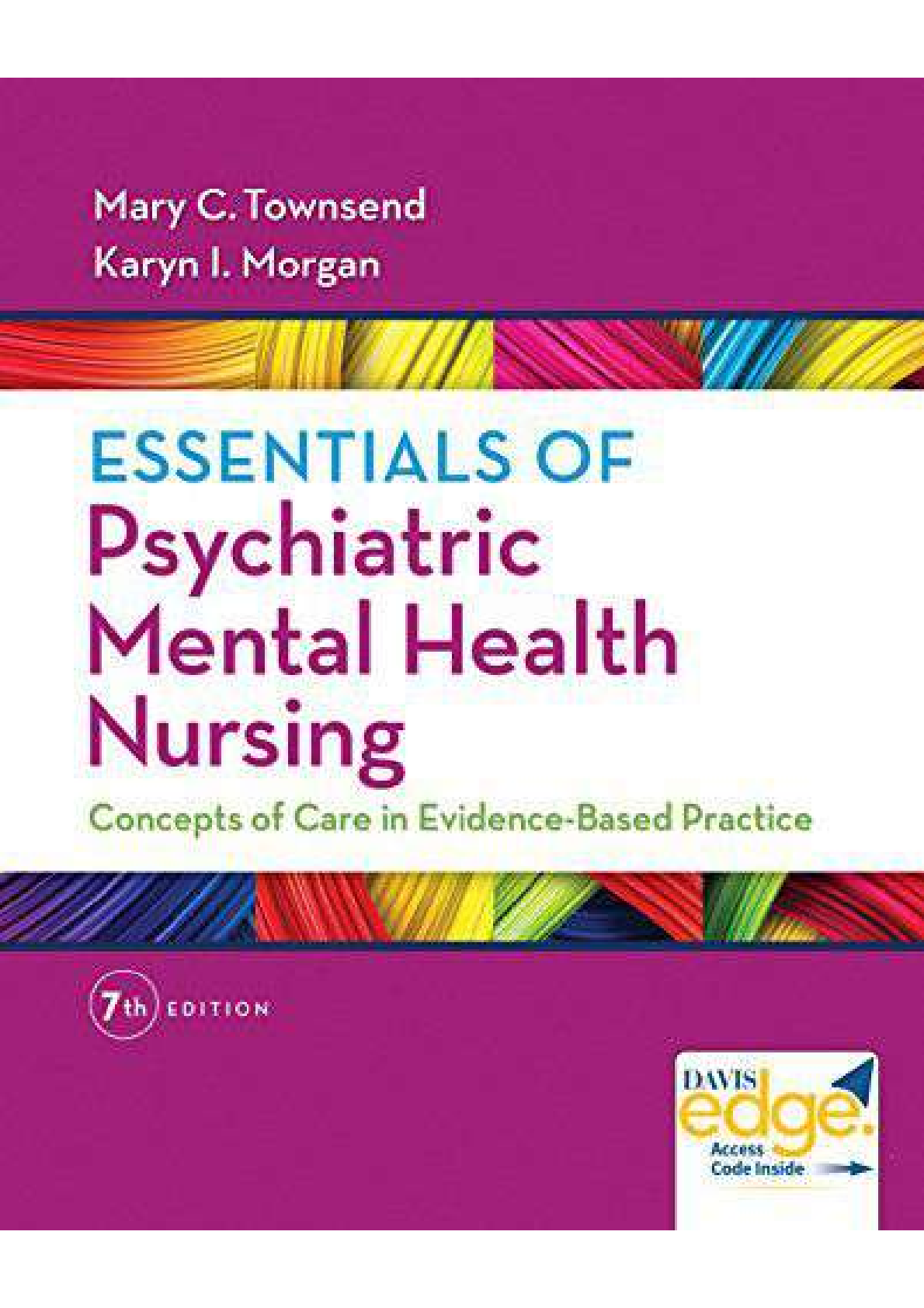
Reviews( 0 )
Document information
Connected school, study & course
About the document
Uploaded On
May 05, 2022
Number of pages
421
Written in
Additional information
This document has been written for:
Uploaded
May 05, 2022
Downloads
0
Views
213



